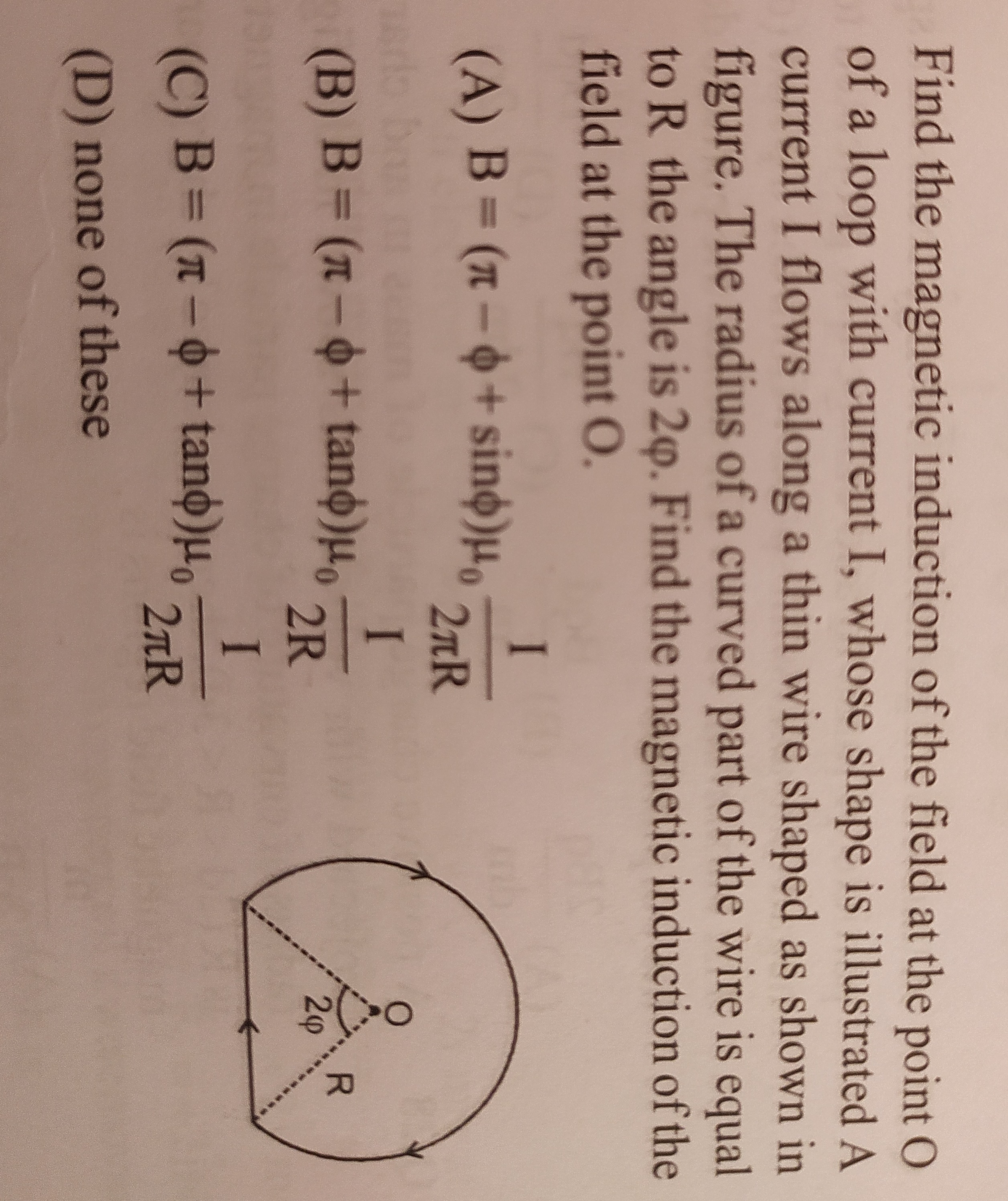Question
Question: Find the magnetic induction of the field at the point O of a loop with current I, whose shape is ill...
Find the magnetic induction of the field at the point O of a loop with current I, whose shape is illustrated A current I flows along a thin wire shaped as shown in figure. The radius of a curved part of the wire is equal to R the angle is 2φ. Find the magnetic induction of the field at the point O.

Β = (π - φ + sinφ)\mu_o$$\frac{I}{2\pi R}
B = (π - φ + tanφ)\mu_o$$\frac{I}{2R}
B = (π - φ + tanφ)\mu_o$$\frac{I}{2\pi R}
none of these
(Α) Β = (π - φ + sinφ)\mu_o$$\frac{I}{2\pi R}
Solution
The magnetic field at point O is the superposition of the fields due to the circular arc and the two straight segments.
-
Magnetic field due to the circular arc (Barc): The point O is the center of the circular arc. The radius is R. The angle of the "missing" part of the circle is 2φ. Thus, the angle subtended by the major circular arc at O is θarc=(2π−2φ) radians. The formula for the magnetic field at the center of a circular arc is B=4πRμ0Iθ. Substituting the angle: Barc=4πRμ0I(2π−2φ)=2πRμ0I(π−φ) By the right-hand thumb rule, if the current flows clockwise along the arc, the direction of Barc is into the page.
-
Magnetic field due to the two straight wire segments (Bstraight): The diagram shows the straight segments meeting at point O. If O lies on the line of the current-carrying wire, the magnetic field produced by that wire segment at O is zero. However, the presence of sinφ or tanφ terms in the options suggests that the straight segments do contribute. This implies a common interpretation where the straight segments are not passing through O, but are tangents to the circle at the ends of the arc and meet at some point P. The diagram is misleading in this aspect. Assuming this common interpretation: The two straight segments are tangents to the circle at the ends of the arc. Let A and B be the points of tangency. These tangents meet at a point P. O is the center of the circle, and OA and OB are radii (length R) perpendicular to the tangents AP and BP, respectively. The angle AOB is 2φ. In the right-angled triangle OAP, ∠OAP=90∘ and ∠AOP=φ. The magnetic field due to a finite straight wire segment at a point is B=4πdμ0I(sinα1+sinα2), where d is the perpendicular distance from the point to the wire, and α1,α2 are the angles made by the lines joining the ends of the wire to the point with the perpendicular. For segment AP, the perpendicular distance from O to AP is d=OA=R. The angles are α1=0∘ (for point A, as OA is the perpendicular to AP) and α2=∠AOP=φ (for point P). So, the magnetic field due to one segment AP at O is: Bsegment=4πRμ0I(sin0∘+sinφ)=4πRμ0Isinφ Since there are two such identical segments (AP and BP), the total magnetic field due to the straight segments is: Bstraight=2×Bsegment=2×4πRμ0Isinφ=2πRμ0Isinφ By the right-hand thumb rule, the direction of Bstraight is also into the page (assuming current flows consistently).
-
Total Magnetic Field (Btotal): The total magnetic field at O is the vector sum of Barc and Bstraight. Since both are directed into the page, they add up: Btotal=Barc+Bstraight=2πRμ0I(π−φ)+2πRμ0Isinφ Btotal=2πRμ0I(π−φ+sinφ)
This matches option (A).
